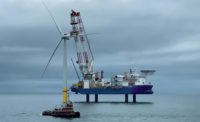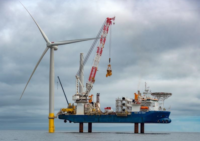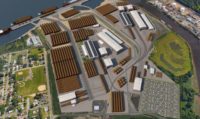New Jersey has awarded more than $1 billion in onshore grid expansion and upgrade projects needed to deliver 7,500 MW from proposed offshore wind farms using a novel “transmission-first” approach that the state said would lower costs, reduce project delays and minimize environmental and local community impacts.
In a long-awaited decision, the state Board of Public Utilities unanimously approved on Oct. 28 a $504-million project proposed by Mid-Atlantic Offshore Development, a venture of utility Jersey Central Power and Light and developers Shell New Energies and EDF Renewables North America. It involves building a new substation at the utility’s existing Larrabee substation in central New Jersey, which would be the single interconnection point for board-approved offshore wind projects.
Another $575 million in added upgrades would be made by utilities and companies that include Atlantic City Electric, Baltimore Gas and Electric, PSE&G, LS Power, Peco Energy Co., PPL Corp. and Transource.
The selection followed months of review by the state and grid operator PJM Interconnection of more than 80 proposals from 13 utilities and companies, but did not include ambitious options for so-called "backbone" transmission facilities to be built in the ocean that would link New Jersey projects, and possibly those of nearby states.
New Jersey now has 3.2 GW of offshore wind capacity under development.
Regulators indicated that building such offshore facilities remains an option, with anticipated federal funding support.
The approach “results in an innovative transmission solution, creating a single onshore point of interconnection while leveraging existing rights of ways,” said state Board of Public Utilities President Joseph Fiordaliso, in announcing the contract awards. He termed the selection "an historic event in the progression of offshore wind," but emphasized that the state is "not finished" with its transmission expansion.
“This represents a landmark development opportunity in new, regulated transmission assets,” a Jersey Central Power and Light spokesperson said.
The total $1.08-billion cost for the Larrabee-centered upgrade equates to $1.03 per month for the average residential customer, the board said, estimating it would save $900 million compared to procuring transmission upgrades from each project. The Larrabee connection reduces the amount of cabling needed to deliver offshore wind energy to the grid, it added.
The transmission plan scope was tailored to maximize federal tax incentives, including those in the new Inflation Reduction Act, by increasing the share of upgrades eligible to receive the Investment Tax Credit, board staff said.
Andrea Hart, board senior program manager for offshore wind, said the sea-based grid was rejected because benefits do not "outweigh the costs at this time,” noting that the tax credit under the new law can be used for generation projects but not for those in transmission. The U.S. Treasury Dept. has yet to issue new clarifying regulations under the law.
But she noted that the state grid plan will benefit offshore wind project developers now "as it minimizes cost and delay uncertainty, ensuring a clearer path forward for developing projects.” The state also is positioned to seek direct federal funding for future expansions, including a backbone award, and now can preserve preferred interconnection locations and transmission corridors for the future.
The board order also authorized a second round of coordinated transmission planning to meet New Jersey’s newly elevated 11,000 MW offshore wind target, which Gov. Phil Murphy announced in September.
The state emphasized that elements of the Larrabee upgrades now will be included in all regional transmission planning to ensure that grid operator PJM "considers the state agreement and the offshore wind projects it will support.”
New England Wind Projects Cost Issue
Despite the New Jersey offshore wind milestone, project developers in New England cite cost risks.
Claiming a significant increase in expected construction costs it attributes to sharp hikes in global commodity prices and interest rates, as well as to persistent supply chain shortages and inflation, Avangrid, the Northeast utility and renewable energy developer, requested a pause by state regulators in review of the 1.2-GW Commonwealth Wind farm now being developed under an agreement with Massachusetts.
The firm wants to renegotiate terms of power purchase agreements it signed earlier this year with utilities.
Also requesting the pause was Shell New Energies and Ocean Winds North America, developers of the 2.4-GW Mayflower Wind project.
“We need to revisit the terms to continue,” Avangrid CEO Pedro Azagra said on a third quarter earnings call Oct. 16. “This is a very serious matter,” he said. He said that the company preference was to continue to build Commonwealth Wind and negotiate “within the framework of our contract,” but emphasized that the firm would not lose money on the project.
“We’re not suggesting we want to make more money," Azagra said. "We just don’t want to lose money.”
In its filing to the state, Avangrid said the one-month suspension would allow time to consider potential approaches to restore project viability—including cost saving measures, tax incentives under the new climate change law, a modest PPA price hike and improvements to project efficiencies.
But on Nov. 4, the Massachusetts utility regulator rejected the requests.
Developers of Mayflower Wind on Nov. 7 withdrew its pause request and said they will “seek to resolve” project economic issues with the state. An Avangrid spokesman said the firm would shortly propose a new plan to state and utility officials and “remains committed ... to find a path forward.”
Paul Patterson, an analyst with Glenrock Associates, said Azagra seemed highly confident the terms would be renegotiated. “But the project is in jeopardy without a change in terms,” he said.
Sy Oytan, Avangrid senior vice president for offshore wind projects, told investors in September the company also would ask Connecticut to renegotiate terms supporting the 804-MW Park City project that were agreed to in 2019. It has not yet filed a request with the state. The project would be delayed until 2027.
All projects would be built off the Continental Shelf south of Martha’s Vineyard.
Avangrid’s third project, Vineyard Wind, now is under construction and expected to come online in 2024, Azagra said. Work is proceeding “well on track,” he told investors.






Post a comment to this article
Report Abusive Comment